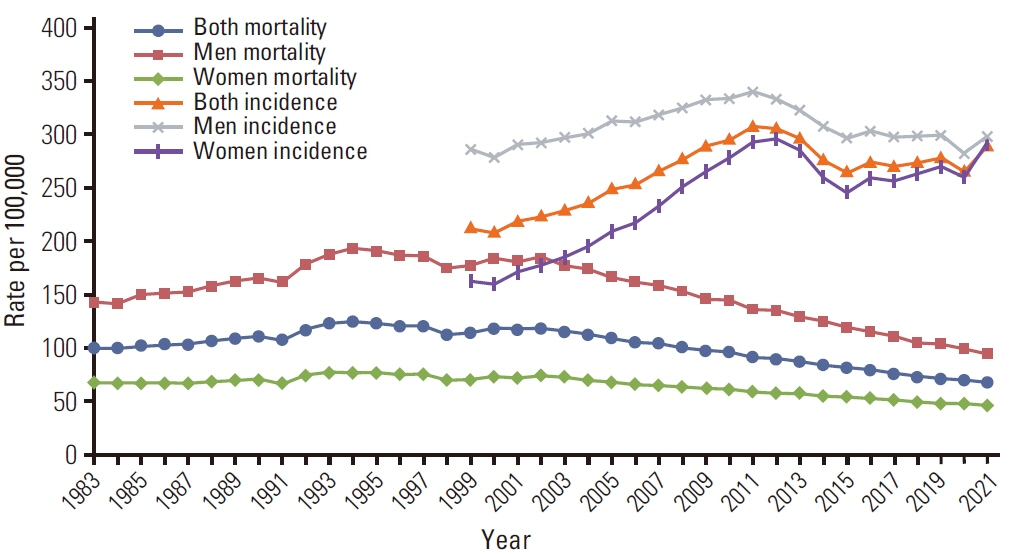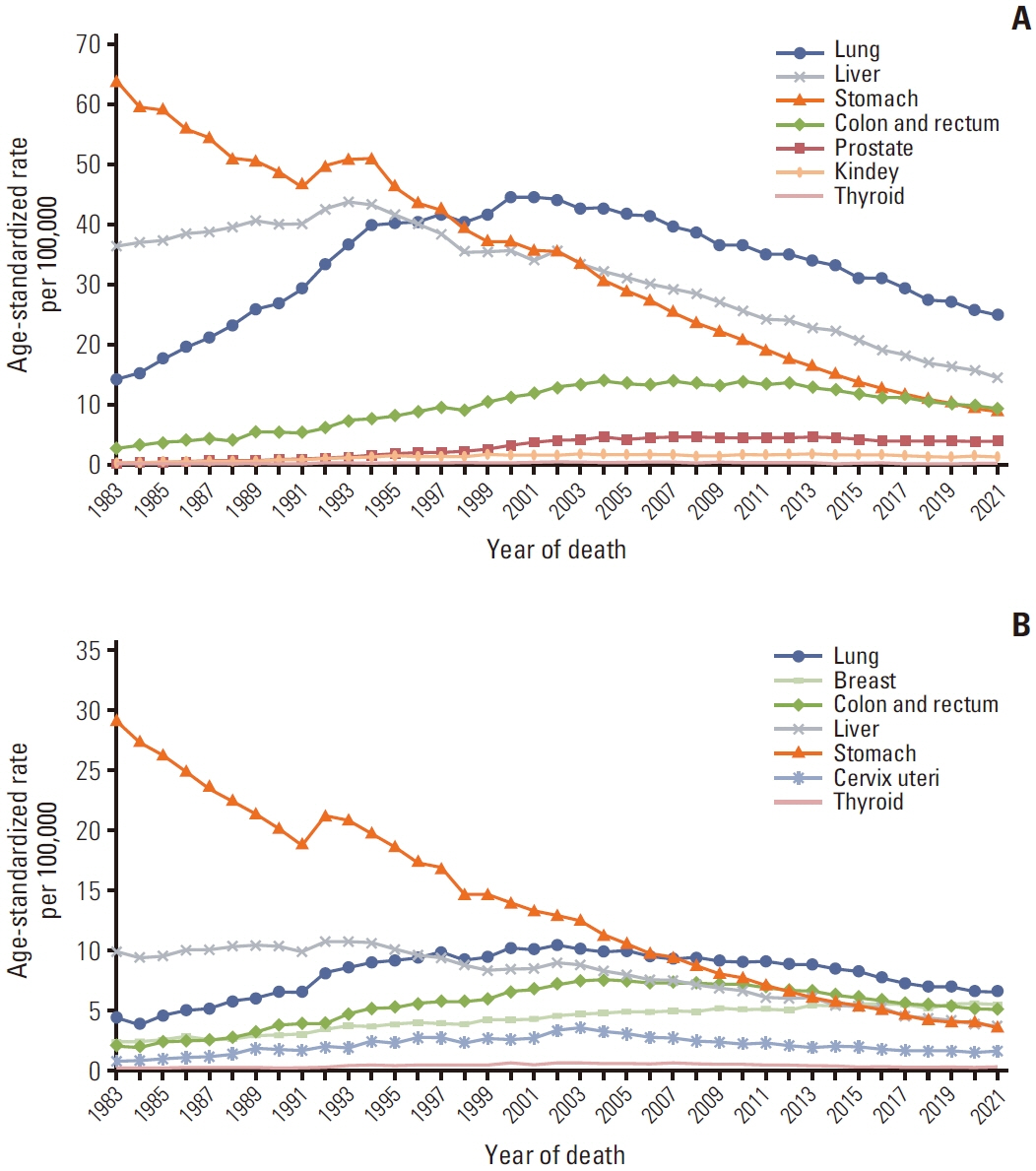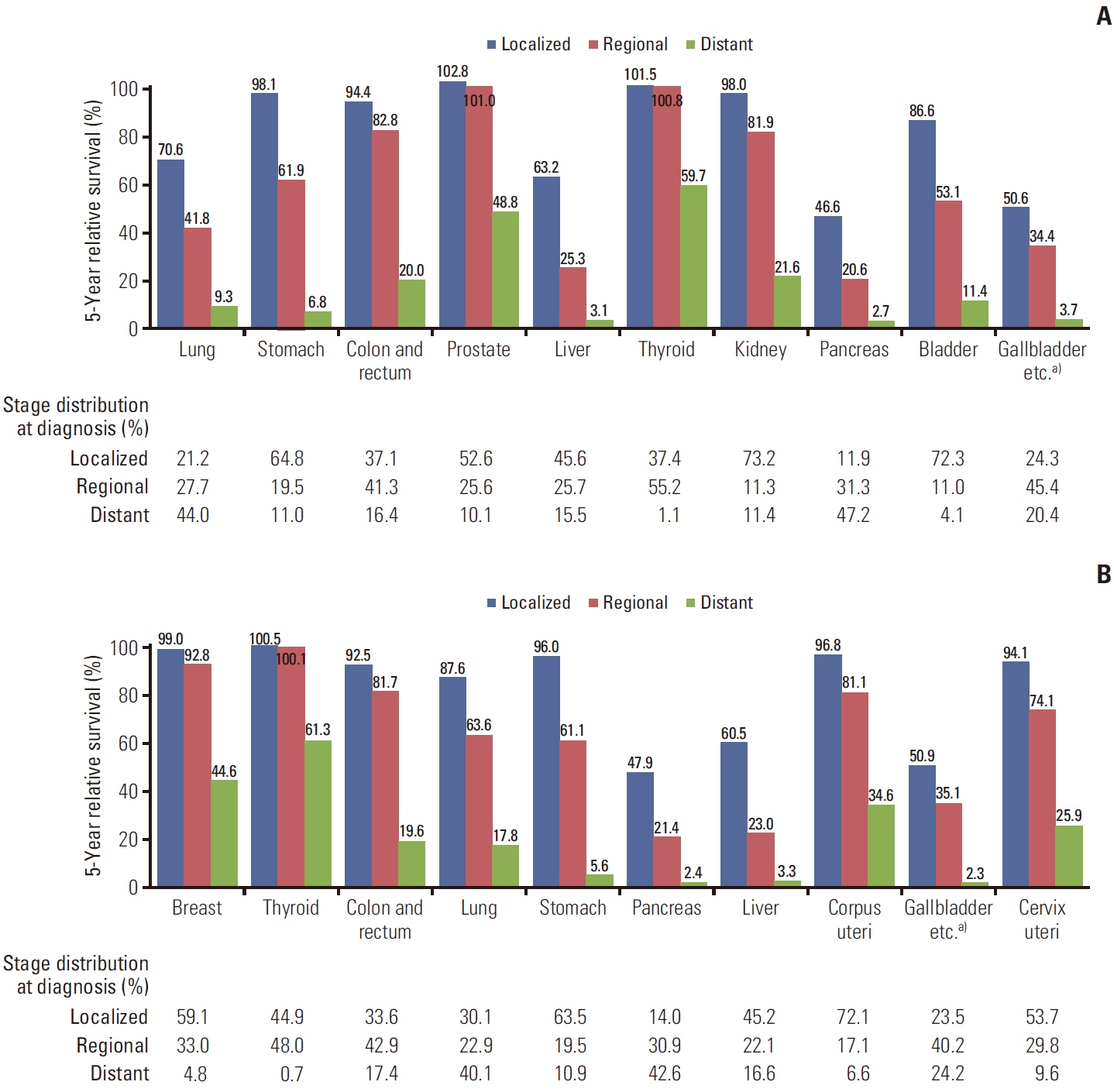Cancer Res Treat.
2024 Apr;56(2):357-371. 10.4143/crt.2024.253.
Cancer Statistics in Korea: Incidence, Mortality, Survival, and Prevalence in 2021
- Affiliations
-
- 1Korea Central Cancer Registry, National Cancer Center, Goyang, Korea
- 2Division of Cancer Registration and Surveillance, National Cancer Control Institute, National Cancer Center, Goyang, Korea
- 3National Cancer Control Institute, National Cancer Center, Goyang, Korea
- 4National Cancer Center Graduate School of Cancer Science and Policy, National Cancer Center, Goyang, Korea
- KMID: 2554328
- DOI: http://doi.org/10.4143/crt.2024.253
Abstract
- Purpose
The current study provides national cancer statistics and their secular trends in Korea, including incidence, mortality, survival, and prevalence in 2021.
Materials and Methods
Incidence, survival, and prevalence rates of cancer were calculated using the Korea National Cancer Incidence Database, from 1999 to 2021, with survival follow-up until December 31, 2022. Deaths from cancer were assessed using causes-of-death data obtained from Statistics Korea.
Results
The number of new cancer diagnoses in 2021 increased by 27,002 cases (10.8%) compared to 2020. In 2021, newly diagnosed cancer cases and deaths from cancer were reported as 277,523 (age-standardized rate [ASR], 289.3 per 100,000) and 82,688 (ASR, 67.6 per 100,000), respectively. The overall cancer incidence rates increased by 3.3% annually from 1999 to 2012, and decreased by 5.3% from 2012 to 2015, thereafter, followed by non-significant changes. Cancer mortality rates have been decreasing since 2002, with more rapid decline in recent years (annual decrease of 2.8% from 2002 to 2013; 3.2% from 2013 to 2021). The 5-year relative survival between 2017 and 2021 was 72.1%, which contributed to prevalent cases reaching over 2.4 million in 2021.
Conclusion
In 2021, the number of newly diagnosed cancer patients increased as healthcare utilization recovered from the coronavirus disease 2019–related declines of 2020. Revised cancer registration guidelines expanded the registration scope, particularly for stomach and colorectal cancer. Survival rates have improved over the years, leading to a growing population of cancer survivors, necessitating a comprehensive cancer control strategy. The long-term impact of the pandemic on cancer statistics requires future investigation.
Figure
Reference
-
References
1. Ferlay J, Ervik M, Lam F, Laversanne M, Colombet M, Mery L, et al. Global Cancer Observatory: Cancer Today [Internet]. Lyon: International Agency for Research on Cancer;2022 [cited 2024 Feb 14]. Available from: https://gco.iarc.who.int/today/.2. Statistics Korea [Internet]. Daejeon: Statistics Korea; 2022 [cited 2024 Feb 14]. Available from: https://kosis.kr.3. Yoo KJ, Lee Y, Lee S, Friebel R, Shin SA, Lee T, et al. The road to recovery: impact of COVID-19 on healthcare utilization in South Korea in 2016-2022 using an interrupted time-series analysis. Lancet Reg Health West Pac. 2023; 41:100904.
Article4. Lee K, Lee YY, Suh M, Jun JK, Park B, Kim Y, et al. Impact of COVID-19 on cancer screening in South Korea. Sci Rep. 2022; 12:11380.
Article5. Siegel RL, Miller KD, Wagle NS, Jemal A. Cancer statistics, 2023. CA Cancer J Clin. 2023; 73:17–48.
Article6. Shin HR, Won YJ, Jung KW, Kong HJ, Yim SH, Lee JK, et al. Nationwide cancer incidence in Korea, 1999~2001: first result using the National Cancer Incidence Database. Cancer Res Treat. 2005; 37:325–31.
Article7. Ajiki W, Tsukuma H, Oshima A. Index for evaluating completeness of registration in population-based cancer registries and estimation of registration rate at the Osaka Cancer Registry between 1966 and 1992 using this index. Nihon Koshu Eisei Zasshi. 1998; 45:1011–7.8. World Health Organization. International Classification of Diseases for Oncology (ICD-O), 3rd ed. 2nd rev. [Internet]. Geneva: World Health Organization;2019 [cited 2024 Feb 14]. Available from: https://iris.who.int/handle/10665/96612.9. World Health Organization. International statistical classification of diseases and related health problems, 10th rev. [Internet]. Geneva: World Health Organization;2009 [cited 2024 Feb 14]. Available from: https://iris.who.int/handle/10665/44081.10. Ferlay J, Ervik M, Lam F, Colombet M, Mery L, Pineros M, et al. Global Cancer Observatory: Cancer Today – data and methods [Internet]. Lyon: International Agency for Research on Cancer;2020 [cited 2024 Feb 14]. Available from: https://gco.iarc.who.int/today/data-sources-methods.11. Bray F, Colombet M, Aitken JF, Bardot A, Eser S, Galceran J, et al. Cancer incidence in five continents, Vol. XII (IARC CancerBase No. 19). Chapter 3. Classification and coding [Internet]. Lyon: International Agency for Research on Cancer;2023 [cited 2024 Feb 14]. Available from: https://ci5.iarc.fr/ci5-xii/chapters.12. Young JL Jr, Roffers SD, Ries LA, Fritz AG, Hurlbut AA. SEER summary staging manual 2000: codes and coding instructions. NIH Pub. No. 01-4969. Bethesda, MD: National Cancer Institute;2001.13. Bray F, Colombet M, Aitken JF, Bardot A, Eser S, Galceran J, et al. Cancer incidence in five continents, Vol. XII (IARC CancerBase No. 19). Chapter 7. Age standardization [Internet]. Lyon: International Agency for Research on Cancer;2023 [cited 2024 Feb 14]. Available from: https://ci5.iarc.fr/ci5-xii/chapters.14. Segi M. Cancer mortality for selected sites in 24 countries (1950-1957). Sendai: Department of Public Health, Tohoku University School of Medicine;1960.15. Ederer F, Heise H. Instructions to IBM 650 programmers inprocessing survival computations. Methodological note, No.10. Bethesda, MD: National Cancer Institute;1959.16. Paul Dickman [Internet]. Stockholm: PaulDickman.com; 2016[cited 2024 Feb 14]. Available from: https://www.pauldickman.com/.
- Full Text Links
- Actions
-
Cited
- CITED
-
- Close
- Share
- Similar articles
-
- Cancer Statistics in Korea: Incidence, Mortality, Survival, and Prevalence in 2008
- Cancer Statistics in Korea: Incidence, Mortality, Survival, and Prevalence in 2018
- Cancer Statistics in Korea: Incidence, Mortality, Survival, and Prevalence in 2016
- Cancer Statistics in Korea: Incidence, Mortality, Survival, and Prevalence in 2014
- Cancer Statistics in Korea: Incidence, Mortality, Survival, and Prevalence in 2015








